Having accumulated about 10,000 miles since a millennium-era restoration, this 1965 Ford Galaxie 500 awaits the top bid of its new owner. Eight suitors have thrown their hat in the ring on this full-size Ford here on eBay. The car is located in Pierce City, Missouri, and bidding sits just above $2000 with the reserve not met.
When this grille fills up your rear view mirror with its stacked vertical headlights and stern bumper, it’s difficult to ignore the message: “Get out of my way.” This generation of the Galaxie began in 1965 and introduced a coil spring rear suspension and Ford’s two-key system (ignition and valet) which carried on through the ’90s. Galaxie sales benefitted from its use in NASCAR, in the days when “Stock Cars” at least had the same body as those sold on the street. (Some details courtesy of Wikipedia.) During these years (1965-68) the “LTD” model signified the top trim level above the mid-level 500 and base Galaxie.
The listing includes no decent picture of the dash, but the seller claims the dealer-installed Air Conditioning unit works but needs recharged. In the old days, it was difficult to order a green car with a blue interior, but this one seems like a factory color-combination.
Ford fans preparing to point out that Galaxies did not receive the Thunderbird-sourced 428 cid motor until 1966 can stand down from DEFCON1; the seller does not claim it was factory-installed. By the badge in the first picture, it appears that Ford’s 352 cid V8 originally powered this Galaxie. The 428 was rebuilt during the restoration with a performance-minded 10:1 compression ratio. The seller makes no performance claims, but gives what appears to be an honest reckoning of the car’s good and bad points. While not a candidate for the ultimate restoration, this mostly-rebuilt air-conditioned driver might suit someone looking to enter the hobby for a modest investment. While not nearly as potent as the NASCAR-spec 427, this big block should have no problem entertaining your neighbors when called upon to convert tires into smoke. So what would you do with this beast?






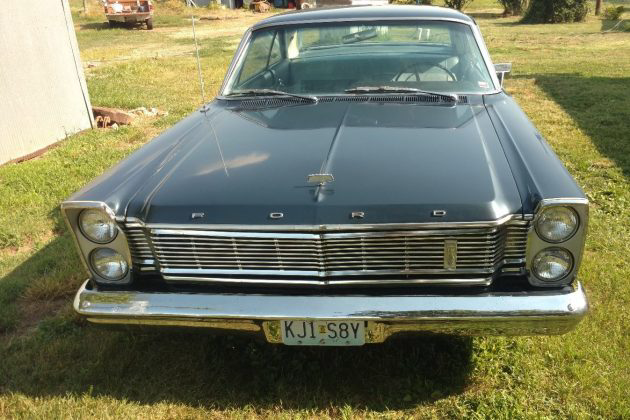
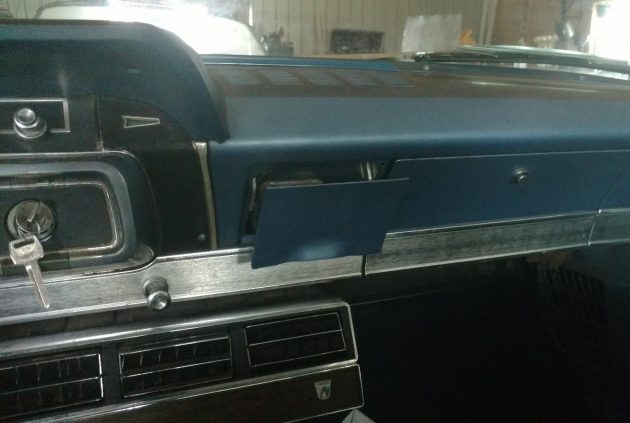
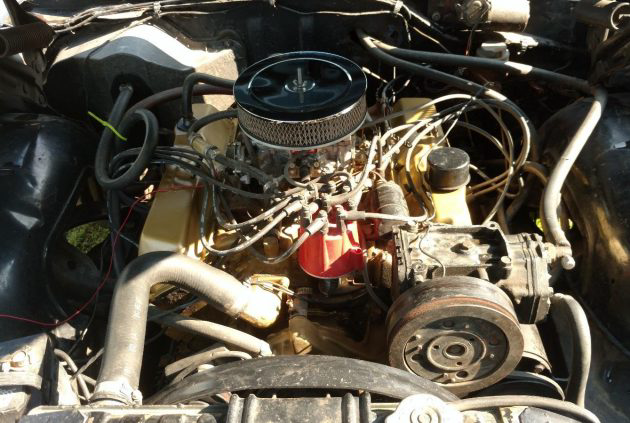
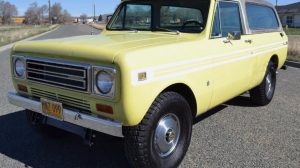

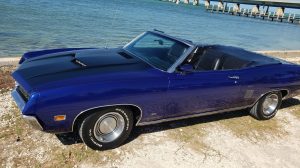
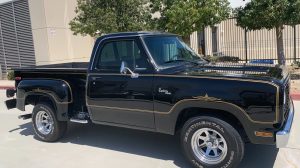


At a decent price, I’d dress it in NASCAR appearance and have fun with it.
The Ford 427 was an FE engine, which is not a “Big Block” but actually the middle-sized of the Ford V8 engine families (Windsor/Cleveland “small” block series, FE “mid” block series, Ford 385 and “Super Duty Truck” “big” block series). The FE was offered in displacements of 332, 352, 361, 360, 390, 406, 410, 427, SOHC 427, and the 428.
So not a big block.
This of course omits the earlier Flathead engines, the Ford GAA, all of the Ford, Lincoln, Mercury, and Edsel Y-Blocks of 1952-1964, the M-E-L V8’s, and all of the modular and later V8’s which came afterward.
Mike,
Seems like everybody wants to call a engine with a lot cubes a big block. Pontiac V8s from 287-455 all used the same block but 421 and 455 get called a big block
Vince,
That’s been my observation also. So far as I know, the only corporate entity which referred to their engines as “Big Block” and “Small Block” was the Chevrolet Motor Division of General Motors. Pretty much all others make reference to which series of motor using some other nomenclature, but using the term Big Block and Small Block have become generic like using the term “Positraction” to refer to any and all varieties of limited slip differential.
I don’t normally get this pedantic, but my first car was a 1965 Galaxie 500 2-Door Hardtop in white with the 352 4V, and at no time did I ever consider the FE engine in there to be a Big Block type. . . I reserved that designation for the later Ford 460 I had; that thing was yo-u-u-u-u-u-j-j!
@ Mike H;
All the engs. you mentioned are considered Big Block Ford engs.(FE) especially in the 60’s when these were the BIGgest BLOCK Ford engs. of their time. The 385 series(429/460) didn’t come out until ’68 in the Lincoln line I believe. This car being a ’65, 3 years before the 429 was released, would be considered in the Big Block line up of that year.
What point are you trying to make?
Full Agreement. Fitch, as an automotive journalist, should know better or do a better of researching. It would have taken 1 or 2 minutes longer to look this up.
Greetings Fellas, I always appreciate the input of subject-matter experts, and I will refrain from calling the FE a “big block” in the future. My 1 or 2 minutes of research revealed differing opinions on what constitutes a Ford big block, even if some are wrong. Luckily I didn’t write a book on the topic! Keep the clarifications coming, though; learning is a life-long process.
http://www.mre-books.com/interchange/interchange10.html
https://www.msn.com/en-us/autos/enthusiasts/forgotten-ford-big-block-makes-a-comeback-at-engine-masters-2016/ar-BBx2IDY
http://www.diyford.com/ford-big-blocks-ultimate-fe-series-332-428-engine-guide/
Well said, Mr. Fitch. I’m no expert on anything, but i understood that this was clearly not a “small-block” given its 428 cu. in. displacement. Accordingly, in my vernacular, of it is not a small block, it is a large block.
So displacement is the differentiator? I’ve misunderstood! The Ford 390 in the FE series is a big block because it has such a high displacement but the Ford 400 is also a. . . Wait, the 400 – with more displacement – is built from the Cleveland block? So the 400 ISN’T a big block, even though it has so many of those cubic inches?
Displacement and physical engine size aren’t precisely linked. Chrysler offered (2) engines of 426 in³, and one of them was physically MUCH larger than the other.
@Mike H;
chebby has a 400 small block & a 400 big block. I say it’s the design of the block that determines the use of big or small block. I never heard of a 409 big block until recent referral’s. The term used in the chebby started with the 396 and has since then been the comparison of small & big blocks in the chebby line. Ford has always used the term since the 427 design was introduced. In today’s terms, with stroking being very popular, the referral of cubic inches is used along with the term small or big block, referring to design of the block. Some times the person will say based off of, say Mopars 318, or chebby’s 327, or Ford’s 351 small block.
Ford always had a two key system in the 60’s. The big Ford and Thunderbirds received the new two sided keys in 65. The square headed one was for the doors and ignition and the round one was for the trunk and glove box.
The was no such thing as a “valet” key back then.
I had a 289/auto 65 Custom 500 sedan I used as a winter beater from 72-75. Bought it with low miles for $300 from my dad’s friend, it was his mom’s car. It was Ziebarted too, so no body rust.
Three years later, the right frame had cracked/rusted through right behind the front wheel. I was horrified something like that could occur.
Ziebart was only as good as the guy applying it.
So, the air conditioner needs TO BE recharged?
This is not from the point of view of the expert, but that of a very old hotrodder that has been around too many years and owns many of these engines.
In the hinterlands, the 260 -350 series Windsor and Cleveland engines are referred to as Ford small blocks. The FE and the Later 385 series engines are referred to as big block. If you want to know the difference, lift one. Just the cast iron intake on the FE engine weighs 70 lbs.
Agreed. I had a 1968 Mustang that I squeezed a 428SCJ into. Flattened the front end even with “big block” springs. The intake needed a chain hoist to remove/install carefully. They were a very wide and heavy engine.
I would let my wife drive it behind my truck to car shows! They had a 4dr in the ’60s.
The reference , for Chevy, small block or big block refers to deck height.
Looking at the three popular engine series today: the Windsor/Cleveland with a bore center spacing of 4.38 inches; the FE series with a bore center of 4.63 and the 385 Series (429/460) with a bore center of 4.9 inches. Cubic inch capacity overlapped: 221 to 400, 332 to 428, 385 (trucks) to 460. So here is why the Fords are grouped into SBF, FE and BBF. IT is pretty clear. Of course not included are several early V8 series and the new modular series.
OK, I lust after this. My parents had a ’65 4-door Galaxie 500 4-door in dark blue–my mother called it Bluebird–with a 289 2bbl. So a 2-door with a 428 is sort of the memory I never had.
Although I do remember getting the car for a date and after taking the girl home and as we got out to walk to her door, the newfangled automatic door locking system lived up to its name. So Sue had to back her parents’ VistaCruiser out over the lawn and drive me home to get the other set of keys. (I have since never left the keys in a car when I get out except the one time in the UK when I locked the keys of the rental Scirocco in the trunk).
Hilarity ensued when I thought I’d introduce Sue to my folks–it would be rude for her to come to the house and not come in–except that in those pre-air conditioning days my father was watching TV in his skivvies. Fortunately I was able to turn Sue around before she was eyeball-to-undies with Dad…who she never met.
Got in contact with her via Facebook and she claims not to remember the story…or me…though I know better of the latter, and now she knows The Rest Of The Story.
So I’d probably not in the interest of current domestic tranquility have this car. I’d tell that story too many times. But I’d like the car. A lot.
Deck height does not define big block or small block Chevy.
Forget all the nomenclatures, acronyms, and deck heights information, just give me the car!
Excellent, who cares who knows more about engine height or weight, that’s a sweet old machine right there !
Cool car, good price. A 390 isn’t a big block? What is this April fools day?
First, know that there are two deck heights on a motor. Block deck height is the measurement from the centerline of the main bearing bore to the flat part of the block deck where the heads bolt on. On a small block Chevy, this dimension is usually given as 9.025″ from the factory. The block deck height is not to be confused with piston deck height, which is the measurement from the piston crown to the block deck where the heads bolt on, with the piston at top dead center.
Great information above on engines! Love those old fords; a decent 14X3 air cleaner and torque thrust d rims are all I would add.
Baloney! An SBC has a bore center of 4.4 inches. A BBC has a bore center of 4.84 inches. A BBC can be had in either of two deck heights. Are you going to call the shorter one a small block (SBC)? Dum beh silleh!
Out of hot rod magazine
Pontiac 421 – 455 medium block Pontiac division made lighter
engines to gain not just performance but speed to.
Lighter same cubes meens faster cars
Ford nomenclature is a lill different frm the chebby.
Here’s another take on it.
The fords, historically, go by ‘families’ i.e.:
thrift power / i6 or / falcon motors (144, 170, 200, 250 / 240,300ci)
FE
Y
etc.
As the industry evolved the motor stayed in ‘that family’ but was factory modified, expanded in cam etc, upsized, ‘improved’. It’s still frm that 1 family.
By referring to the Pontiac as a medium block, you are implying that there is a smaller block or a larger block when there is neither. The blocks were ALL machined on the same line of equipment from the beginning. There was a SHORT DECK version to support the 265 and 301 engines but all had the same bore centers of 4.62 inches. This engine will support up to 615 cubic inches.
X2 Pontiac only made one casting of the V8 from 1955. The nomenclature of big block vs small block started with Chevy, when they came out with the 348 in 1958. Hot rodders started calling the 348 the big block, because it was over 100 lbs heavier than the original 265-283 small block.
The terminology stuck, and by the early sixties, all the big three had a large block engine and a lighter engine, so the lighter Fords became sbf, and Chryslers became sbc..
The naming has nothing to do with the ultimate number of cubic inches, deck height, or bore spacing.
.
Good stuff! Not to make light but I’m still having trouble hearing some motor-head saying “Boy this thing will be a beast after I drop that mid-block in there.” I guess if you know what you’re talking about you might say “…drop that FE in there.” lol
Lest you forget, the 390 motor began life as a 332 cu. in. That is why you cannot go by cubic inches in defining a big block of a small block. Its life cycle ran the displacement up to 428 and aftermarket it can grow even larger.
Similarly, the 400M engine began life as a 221 cu. in. engine. The deck was raised in making the 351W, the 351C and the 351 M engines and raised again the make the 400M. However the bore centers are the same.
Folks have to realize that it is the bore center that defines one engine series from another by the same manufacturer. Read up guys and get on your game!
Have fun.
Lest you forget, the 390 motor began life as a 332 cu. in. That is why you cannot go by cubic inches in defining a big block or a small block. Its life cycle ran the displacement up to 428 and aftermarket it can grow even larger.
Similarly, the 400M engine began life as a 221 cu. in. engine. The deck was raised in making the 351W, the 351C and the 351 M engines and raised again to make the 400M. However the bore centers are the same.
Folks have to realize that it is the bore center that defines one engine series from another by the same manufacturer. Read up guys and get on your game!
Have fun.
There is no 400M, only a 351M. The 400 is a 400, period. And it didn’t begin as a 221 cu. in. engine. The 221 evolved into the 260, 289, 302, and then the 351W.
@Todd Z,
I agree with what you say about the 221- 351W, but I remember seeing a sticker on the truck core supports or under the hoods that would refer to them as 351M/400M. Am I wrong?
Todd, We ought to know what we’re talking about; we’re all car guys and you are a professional journalist.
jeff6599 – Yes! I agree 100% Maybe you haven’t read the entire thread. I have certainly learned about the block designations and intend to be more accurate in the future. My last post was meant to be funny but not sarcastic. I think you’ll have people who love cars and are fine going through life calling anything over 390 or 400 cid, or maybe anything over 500 lb, etc. a “Big block” and (compared to more dangerous mistakes) inaccurate nomenclature is unlikely to tarnish the hobby overall. I’ll do my best and never mind being set straight.
Hot Rod Network…”there were neither”
One of Tom’s first tasks in Special Projects was to order a tall-deck 400 four-bolt main-block (all Pontiac production 400s were tall-deck) and have it delivered to Pontiac Engineering’s machine shop, where the machinists prepped it to his specifications (0.030-overbore). Tom had connections with Moldex and asked them to manufacture the 2.84-inch-stroke cranks. He supplied the company with marked blueprints of the Pontiac 400 crank noting the changes he needed. He also arranged for Carrillo to build the 7.08-inch rods for the experimental engine.
Hot Rod Network “there were neither?” short deck
Likely sometime in late 1970 or early 1971, Tom built the first Pontiac 366 engines for NASCAR. He started with short-deck 303 blocks cast by Pontiac, and then ordered 3.375-inch-stroke Moldex cranks, 6.08-inch Carrillo connecting rods, and 4.15-inch pistons and used modified R/A-IV heads. He directed its power development in the dyno lab, and it produced 575 hp on a PMD dyno. This was 100 hp more than the 303, so I figured we must have hit the sweet spot for the Pontiac V-8.
By calling an engine a tall deck is implying that there was at least another version to compare it with. All 400s were really the so called standard deck height of 10.24 inches. There were short decks made years after the standard deck began production in 1955. Most were built as the 265/301 platform. Just a few 303 short deck blocks were made in 1969 to platform the new Trans Am Race Series motor. This was not successful and never made it to production
IIRC, FE stands for Ford Edsel–used the what I called big blocks.By any name, that 65 would have been no slouch with a 352 4v; with a 428 a great sleeper.These cars were notorious for rotten frames,,even early on only a few years old. Don’t see many in the rustbelt where Ilive here in NY….too bad,fun car to drive with plenty of power.
You are correct, just as MEL stood for Mercury Edsel Lincoln.
Valet key? You meant a trunk key, right ?
Hi W9BAG – Yes – I lifted the word “valet” from one of the web sites – Wikipedia I think, but that does sound funny. If anything the Ford ignition key would be more of the “valet” key in the sense that it didn’t open the glove-box or trunk.Sorry for the confusion. One of my daughters asked me recently why my ’89 Mustang 5.0 has two keys so I had to explain the whole thing. Thanks for challenging my poor research!
‘Ford fans preparing to point out that Galaxies did not receive the Thunderbird-sourced 428 cid motor until 1966 can stand down from DEFCON1;…’
How classic a comment is THAT?!
@Utes,
Don’t get the statement, {‘Ford fans preparing to point out that Galaxies did not receive the Thunderbird-sourced 428 cid motor until 1966 can stand down from DEFCON1;…’} or the reference to DEFCON1. ??????
Please explain.
DEFCON 1, is the acronym for Defense Condition 1. The meaning goes back to the days when Russia (USSR) was our formal enemy, and ranged from DEFCON 5 to 1. DEFCON 5, was the normal condition of readiness, and DEFCON 1, meant that a state of nuclear war exists.
@Utes,
BTW, I was talking to a guy that has two 428 powered ’66 T-Bird from the factory. He has multiple high performance Ford’s, including ’65 427 Galaxie, an A/FX car, etc. He told me something I hadn’t heard before. I had asked him if they came with “Nodular” cases, and he inform me these 428 powered T-Bird’s had the 9.3/8″ ring & pinion differentials. I didn’t even know the 9.3/8″ was around back then. I’m always trying to learn new stuff.
Look at that dashboard with the big ashtray front and center. Won’t be long before people will be amazed that cars once came with a little receptacle in the dashboard to put burned plant ashes.
Zuerch, You are correct, there is no M following the 400, But the engine bore center is 4.38 inches, exactly the same as the 221, 260, 289, 302 etc. All bored on the same machinery line, simply different deck heights.
@jeff6599,
I thought the 221-351W were designed and machined in Winsor, ON, Canada.
I thought the 351C/351M/400 were designed and machined in Cleveland, OH.
I also thought the 351’s M stood for modified.
??????????
Depending on who you read, “M” stands for Midland, Michigan, and Modified. Ford never specified what it meant in any official documentation, hence the different names.
How do they achieve the different deck height?
My memory is that they say ‘351M/400’ but my memory may be bad!
Here’s a link to the 351M/400 valve cover decal:
http://shop.broncograveyard.com/mobile/1977-351_400-Valve-Cover-Emission-Decal/productinfo/29872/
@ Todd Z,
Very good. This link should settle our memories. I bow to the man.